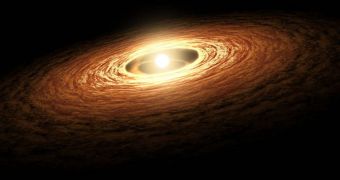In a paper to appear in an upcoming issue of the Astrophysical Journal, researchers suggest that extrasolar planets generally start developing around stars that have high concentrations of chemical elements heavier than hydrogen and helium.
Interestingly, the team that conducted the new study found that exoplanets can form around stars with lower metallicity as well, but the phenomenon was found to be less common. What this research reveals is a general trend, Space reports.
Planets form from structures called planetesimals, which in turn are nothing more than large aggregates made of dust grains. These grains develop in the protoplanetary disks that circle newly-formed stars.
The grains are made up of chemical elements heavier than hydrogen and helium, such as carbon, silicon, oxygen and iron. Therefore, it stands to reason that they can be created a lot easier around stars that are rich in these elements.
The new investigation was carried out by researchers Jarrett Johnson and Hui Li, who are both based at the US Department of Energy's (DOE) Los Alamos National Laboratory (LANL), in New Mexico.
Their study also shows that protoplanetary disks do not survive for prolonged periods of time, if the stars they circle are metal-poor. Therefore, higher metallicities significantly increase the chances of planets developing around a new star.
“Our calculation is an estimate of the minimum amount of heavy elements that must be present in circumstellar disks before planets can form. Because these heavy elements must be produced by the first stars in the universe, the first planets could only form around later generations of stars,” Johnson explains.
The team determined that an Earth-like, rocky planet can only form around a star that has at least 10 percent the metallicity level of the Sun. Beyond this threshold, there are simply not enough heavy chemicals to allow for such a large and dense structure.
“This suggests that many generations of stars had to form and evolve before habitable planets could form,” Johnson concludes.

 14 DAY TRIAL //
14 DAY TRIAL //